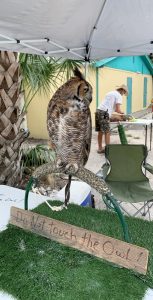Calling all night owls, Audubon’s Corkscrew Swamp Sanctuary Boardwalk after hours event is a great way to learn about Florida’s owls while being in their environment for the night.
Retired FGCU professor of Ecological Sciences, Jerome A. Jackson, was the main speaker during the Nov. 8 nighttime event.
Jackson talked about the diversity, adaptations and conservation of owls in Florida Ecosystems. His knowledge of owls started at a young age as he started raising barred owls as a two-year-old.
“Florida owls are often thought of as the night shift among avian predators,” Dr. Jackson said. “There have been many that are active in the light as well.”
Explore the boardwalk at Corkscrew while being under the stars and listen to the many sounds at night. Corkscrew’s boardwalk volunteer naturalists help guide people throughout the 2.5 mile boardwalk.
A wide variety of Barn Owls, Eastern Screech Owls and Great Horned Owls use old nests to raise their young.
“The Burrowing Owl survives in our cities, but are under constant threat from diverse human actions,” Jackson said.
The tigers of the woods, known as the Great Horned owl, loves to eat skunks. They use old hawk nests throughout North America.
“This system actually helps them grow up to be a successful bird,” Jackson said. “Their defense mechanism is raising their ears when anything/anyone get near them and they feel threatened.”
Red, grey and brown colored faces are the Eastern Screech owls. They are the smallest resident owl. If they are scared, they will suck in as much air as they can to make themselves look very skinny. They eat a wide range of insects and regularly hunt during the day.
Visiting Corkscrew Swamp is an engaging way to learn about the environment. Students can enjoy a peaceful walk with the use of the moon light to guide them through the woods.
If students are lucky, they can see an owl in action and take in the beauty of these birds. Those interested can find information about these walks on the Audubon Corkscrew Swamp Sanctuary website.







